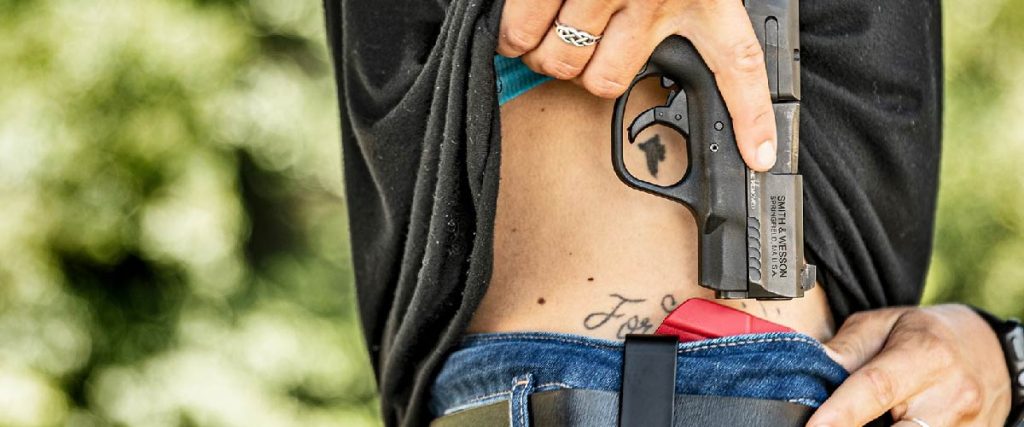Shares of Smith & Wesson Brands, Inc. lost about 17 percent of its value on Wednesday after the firearms maker reported a 47.5 percent drop in sales in the second quarter ended October 31 due to ongoing inventory rebalancing in the marketplace, combined with the impact of promotional activity by competitors and the trading down by consumers to a lower-priced product.
On a call with analysts, Mark Smith, president and CEO, said sales and profitability remain above pre-pandemic levels, with the year-over-year decline reflecting a surge in demand in the year-ago period tied to the pandemic. He also noted that more normal demand levels are expected in the second half of its fiscal year; however, consumer demand for firearms decreased in the latter half of its second quarter.
In the quarter, sales fell to $121.0 million from $230.5 million a year ago, missing analysts’ consensus target of $159.9 million. Sales were 6.4 percent higher than the comparable quarter in 2019, the last pre-pandemic comparable second quarter.
Gross margin eroded to 32.4 percent compared with 44.3 percent in the comparable quarter in 2021 and 28.4 percent in the comparable quarter in fiscal 2020. Excluding costs related to relocating its headquarters and certain manufacturing and distribution operations to Tennessee, gross margin would have been 33.9 percent.
The decrease in margins from 2021 was also due to a combination of reduced sales volumes across nearly all product lines, the impact of inflation on material and labor costs, unfavorable fixed cost absorption due to lower production volume, unfavorable product liability, and inventory valuation adjustments partially offset by decreased compensation costs. Versus the 2019 second quarter, gross margin saw a 4 percent improvement due to an increase in average selling prices (ASPs).
GAAP net income was $9.6 million, or 21 cents per share, compared with $50.9 million, or $1.05, for the comparable quarter last year and $343,000, or 1 cent per share, for the comparable quarter in fiscal 2020.
Non-GAAP net income was $12.0 million, or 26 cents, down 78.3 percent from $55.3 million, or $1.13, for the comparable quarter last year, but ahead of earnings of $520,000, or $0.01, netted for the comparable quarter in fiscal 2020. Wall Street’s consensus EPS target was $0.44.
GAAP to non-GAAP adjustments for income exclude costs related to the planned relocations, the spin-off of the outdoor products and accessories business in fiscal 2021, COVID-19-related expenses and other costs.
Smith said firearms demand, measured by NICS, was largely consistent from its fiscal Q1 to Q2, tracking below the surge period. The trend worsened in the latter half of S&W’s second quarter, as evidenced by the accelerated year-over-year decline in monthly NICS, ending with October only nominally increasing sequentially and representing the lowest sequential increase over September on record. Smith added, “Not surprisingly, this deterioration coincided with the broader consumer slowdown, driven by persistently high inflation, the beginning of the winter heating season across the northern half of the country and rising interest rates.”
On the positive side, the most recent data for November NICS released last week indicated a return to more normal demand patterns, and firearm demand remains healthy compared to historical levels and remains elevated compared to its previous pre-pandemic fiscal year ended May 2020. Smith said, “This indicates that the temporary headwinds are being offset by longer-term tailwinds.”
Smith noted that more than ten million new consumers were added to the firearms market over the past 18-to-24 months, many of whom are returning for subsequent purchases.
“With these new entrants, previous studies indicating that firearms enthusiasts will own an average of 7-to-8 firearms, and recent data showing that concealed carry is on the rise, we believe long-term demand trends remain very healthy,” said Smith. “However, with the uncertainty surrounding the current economy and its impact on firearm demand levels, many firearm retailers and distributors continue to take a cautious approach and continue to adjust inventory levels. This is creating a near-term headwind to our business, as we discussed in the last earnings call. Importantly, this is a normal and healthy process and consistent with how we have seen the market adjust in past periods following significant surges in demand.”
Smith also noted that inventory levels for Smith & Wesson products within its distributors and strategic retail accounts were down considerably sequentially and versus the prior year, marking the third consecutive quarter of significant channel inventory decline and indicating a solid pull-through of the company’s products at retail. He said, “All this means we remain in a highly competitive environment, and winning profitable market share at the consumer level remains our core focus. With many consumers squeezed by inflation and record prices for household essentials, consumer price sensitivity on discretionary purchases has increased, predictably, leading to increased promotional activity within the firearms space.”
The CEO added that while higher ASPs have helped the company mitigate inflationary pressures and partially offset lower volumes, the company could increase promotional activity on certain core product lines in the second half of its fiscal year “to address the realities of the current challenging economic conditions. Additionally, and now more than ever, innovation and new product introductions are critical to continuing our leadership position in the industry.”
















